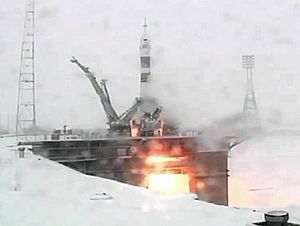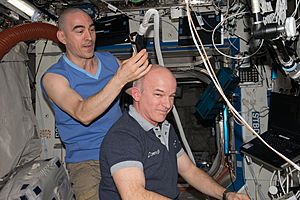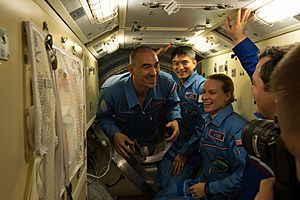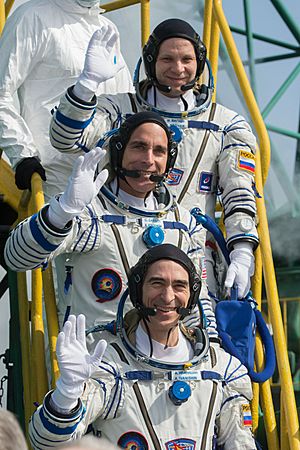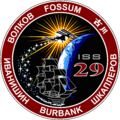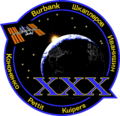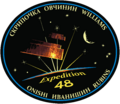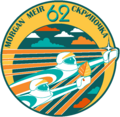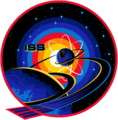Anatoly Ivanishin facts for kids
Quick facts for kids
Anatoly Ivanishin
|
|
|---|---|
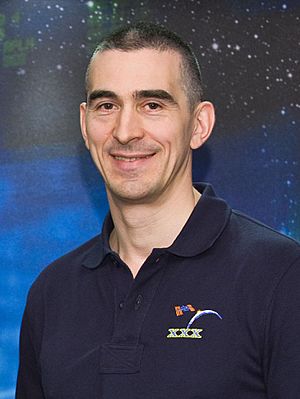
Ivanishin in 2011
|
|
| Born |
Anatoli Alekseyevich Ivanishin
15 January 1969 Irkutsk, Russian SFSR, Soviet Union
|
| Status | Retired |
| Alma mater |
|
| Occupation | Pilot |
| Awards |
|
| Space career | |
| Roscosmos cosmonaut | |
| Rank | Colonel, Russian Air Force (reserve) |
|
Time in space
|
476 days, 4 hours, 41 minutes |
| Selection | TsPK-13 Cosmonaut Group (2003) |
| Missions |
|
|
Mission insignia
|
|
| Retirement | 15 October 2021 |
Anatoli Alekseyevich Ivanishin (Russian: Анатолий Алексеевич Иванишин) is a former Russian cosmonaut. He was born on January 15, 1969. He has traveled to space three times, spending a total of over 476 days orbiting Earth. He even commanded the International Space Station (ISS) during one of his missions!
Contents
About Anatoli Ivanishin
Anatoli Ivanishin was born in Irkutsk, a city in Siberia, Russia. He is married to Svetlana Ivanishina, and they have a son named Vladislav, who was born in 1993. His parents are Alexey and Nina Ivanishin.
His Education and Training
Anatoli Ivanishin finished high school in Irkutsk in 1986. He first tried to get into the Chernigov Higher Military Aviation School for Pilots but didn't succeed. He then studied at the Irkutsk Polytechnic Institute for a year. In 1987, he tried again and was accepted into the Chernigov Higher Military Aviation School. He graduated with top honors in 1991. Later, in 2003, he also earned a degree in Economics from Moscow State University.
His Time in the Military

After finishing aviation school in 1991, Ivanishin became a pilot in the Russian Air Force. He flew MiG-29 jet fighter planes. Later, he became a senior fighter pilot and flew Su-27 jet fighter aircraft. He spent 507 hours flying and made 180 parachute jumps during his military career.
Becoming a Cosmonaut
On May 29, 2003, Anatoli Ivanishin was chosen to become a cosmonaut candidate. He started his special space training on June 16, 2003. He passed all his exams with excellent marks on June 28, 2005. A few days later, on July 5, 2005, he officially became a test cosmonaut.
Anatoli Ivanishin retired from the Cosmonaut training center on October 15, 2021. He decided to focus more on scientific work.
First Space Mission: Expedition 29/30
Anatoli Ivanishin's first trip to space began on November 14, 2011. He launched aboard the Soyuz TMA-22 spacecraft as a flight engineer. His crewmates were Russian cosmonaut Anton Shkaplerov and NASA astronaut Daniel Burbank. They arrived at the International Space Station (ISS) on November 16, 2011.
They joined the Expedition 29 crew already on the station. A few days later, the Expedition 29 crew left, and Daniel Burbank took command of the station for Expedition 30.
On February 16, 2012, Ivanishin helped his fellow cosmonauts, Shkaplerov and Kononenko, during a spacewalk. They spent over six hours outside the station, setting up experiments and moving equipment. Ivanishin and Burbank stayed inside the Soyuz spacecraft, ready in case of an emergency.
Their return to Earth was delayed, but Ivanishin, Shkaplerov, and Burbank landed safely in Kazakhstan on April 27, 2012. This first spaceflight lasted 165 days.
Second Space Mission: Expedition 48/49
For his second mission, Ivanishin was assigned to Expedition 48/Expedition 49 on the ISS. He was a flight engineer for Expedition 48 and then became the commander for Expedition 49.
He launched into space on July 7, 2016, aboard the Soyuz MS-01 spacecraft. His crewmates were JAXA astronaut Takuya Onishi and NASA astronaut Kathleen Rubins. They spent two days testing new systems on the Soyuz MS spacecraft before docking with the ISS on July 9. They joined the Expedition 48 crew already on board.
Expedition 48 ended on September 6, 2016. After that, Ivanishin took command of the station for Expedition 49. More crew members arrived on October 21, 2016, aboard Soyuz MS-02.
After a short time with the new crew, Ivanishin handed over command of the station. He returned to Earth with his two crewmates on October 29, 2016. This mission lasted 115 days, bringing his total time in space to 280 days.
Third Space Mission: Expedition 62/63
Ivanishin's third mission began on April 9, 2020. He launched aboard Soyuz MS-16 with Ivan Vagner and NASA astronaut Christopher Cassidy. They arrived at the ISS six hours later, joining the Expedition 62 crew.
After eight days, the Expedition 62 crew departed. Ivanishin and his two crewmates then became the Expedition 63 crew, with Christopher Cassidy as the commander.
During Expedition 63, the crew welcomed the Crew Dragon Demo-2 mission. This was a very important flight because it was the first time a crewed spacecraft launched from U.S. soil since 2011. NASA astronauts Doug Hurley and Robert Behnken stayed on the ISS for two months during this mission.
Images for kids
See also
 In Spanish: Anatoli Ivanishin para niños
In Spanish: Anatoli Ivanishin para niños


